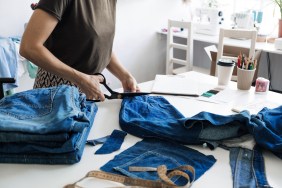We all know that the topic of reducing waste is a major point of contention in the fashion space. Most of us have also heard about the frightening stat that of the 100 billion garments produced each year, 92 million tonnes end up in landfills. In the midst of all of our hectic and often very stressful lives it can be tough to keep these considerations front and center in our rush to click and buy, but we really don’t need to go that far out of our way.
I’m a bit of a shopaholic (currently on a serious Olivia Rubin binge…), so I’m the first one to admit I don’t shop exclusively earth-friendly brands, but I do make an effort to add them to my mix. When I heard about Mill & Moss it reminded me of why.
The brand began by tackling the question: where do clothes come from? And where do they go after the trend cycle has consigned them to the bin? They set out to build a brand that exists on a longer timeline than the trend cycle, for people who are moving their lives to be more in tune with the earth’s cycles. Their clothes are classic in the literal sense: designed to be forever part of the earth’s ecosystem.

To get more insight into the mission and why we should all move from caring “in theory” to “in practice,” about this mission, I spoke with founder Alex Feldstein.
“Mill and Moss brings together agriculture communities, conscious consumers and restorative production processes to heal our soil, our relationship to each other, and our relationship to the earth,” says Feldstein. “Our garments connect wearer to grower, providing a link between fashion and agriculture that many forget.”
She goes on to note that 60% of clothing being sold today is made from plastic. “Mill and Moss is committed to changing this number by producing plastic free garments made from 100% natural fibers. Around 5 million metric tons of synthetic microfibers from washing clothing have been emitted into our waterways. Every time we do the laundry, around 9 million microfibers are released.”

Plastics aren’t just bad for the environment but for our bodies as well, which is something I know all too well as I needed IVF for both my children because of a hormone disrupting syndrome called PCOS, which many think is caused by micro plastics in our environment. “Micro plastics are now being found in placenta and our bloodstreams. We are constantly eating, drinking, and breathing in these particles.”
Feldstein goes on to list a number of shocking stats: the average consumer purchases 60% more clothing than 15 years ago and 90% of all garments produced yearly end up in landfills. The average American consumer throws out around 80 pounds of textiles per year. “We believe less is more, by creating curated, sophisticated, wearable pieces that can withstand trends and seasons.”

It’s hard to discuss the environnemental impacts of fashion without touching on the social.
“There are 40 million garment workers worldwide, 85% of which are woman,” notes Feldstein. “With only 3% of fashion in produced in the United States more than half of all garments are made in countries with very few rights protecting workers. Seeing these atrocities, we manufacture our garments in the United States in safe environments, where our workers are paid above minimum wage. Humans shouldn’t have to suffer when producing clothing.”






